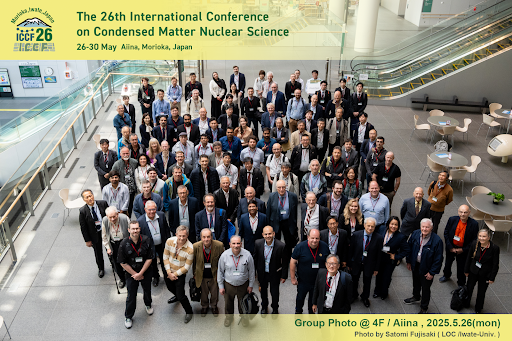Hosted at the Aiina Center and organized in partnership with Iwate University, ICCF-26 was notable not only for the quality of its program but also for the exceptional hospitality and organizational care shown by its Japanese hosts. As a sponsor and active participant, the Solid State Fusion (SSF) team left energized, informed, and committed to helping move this field forward.
Japan was more than just a host; it was a scientific leader. The level of technical rigor, clarity, and experimental design demonstrated by Japanese researchers set a high bar. Presentations consistently showcased careful experimental work and a commitment to exploring foundational mechanisms.
Japan’s investment in this area is visible and growing from university labs to private companies, . Clean energy, long-term sustainability, and scientific integrity were recurring values across the Japanese contributions.
Condensed matter nuclear science (CMNS) is gaining definition not just as a research area but as an emerging field with clearer priorities, methods, and collaboration frameworks.
Several recurring themes emerged across the program. Material science played a foundational role, with much attention paid to the preparation, structure, and treatment of hydrogen-loaded materials. Heat generation remains the most common experimental signal, but growing emphasis is being placed on different diagnostics, from radiation calorimetry to surface analytics. Theory and modeling are emerging alongside the robust experimental literature, with new attempts to ground anomalous effects in known physical frameworks or propose testable mechanisms.
Reproducibility and validation remain central to many discussions. Researchers emphasized precise measurement techniques, independent replication, and robust control protocols. There was a shared interest in securing funding sources, open-source research, and creating pathways to application, especially in the context of climate, energy resilience, and decentralized power generation.
This year’s conference also reflected the field’s maturing relationship with industry. Talks from private sector teams and start-ups focused on device engineering and business readiness. While commercialization remains a long-term goal, foundational research is beginning to inspire ideas about prototypes with potential real-world impact.
At the forefront of the Anthropocene Institute’s research engagements, affiliates are advancing rigorous experimental and theoretical frameworks. Florian Metzler presented his team’s development of a modular platform for palladium (Pd) and titanium (Ti) gas-loading experiments. This system integrates real-time radiation detection with high-resolution surface mapping, enabling a more precise correlation between experimental inputs and observable phenomena. Metzler also articulated a critical view of the field’s inertia, identifying structural and epistemic barriers and proposing strategies to provoke a transformative “phase change” in LENR research. In a complementary effort, Jonah Messinger’s presentation at ICCF26 introduced a novel nucleonics approach grounded in Dicke’s theory of superradiance. He proposed that coherent nuclear excitation transfer in solids, or “supertransfer,” may offer a viable mechanism for LENR.
Peter Hagelstein presented a theoretical model describing nuclear processes in solid-state environments, with a particular focus on how phonon interactions (vibrational modes in a crystal lattice) affect energy exchange and fusion rates. His work contributes to ongoing efforts to explain observed anomalies in condensed matter systems by grounding them in known physical mechanisms.
Jirohta Kasagi introduced a novel diagnostic method known as radiant calorimetry. This methodmeasures thermal radiation across a wide energy range to quantify heat flow in thin metal films. This technique is particularly well-suited for studying excess heat generation in metal-hydrogen systems under low-pressure and high-temperature conditions, offering a potentially more reliable means of heat measurement than traditional calorimetry.
Yasuhiro Iwamura provided a historical overview of LENR research in Japan, highlighting decades of sustained collaboration among universities, industry, and government institutions. These efforts have led to reproducible anomalous heat effects and incremental scientific progress. Iwamura emphasized the potential of condensed matter nuclear science as a compact and commercially viable technology that requires minimal hydrogen. He advocated for stronger theoretical foundations, practical and replicable methods, and integration with mainstream condensed matter physics, cautioning against premature nuclear interpretations.
Konrad Czerski reported on findings from the European CleanHME Project, which ran from 2023 to 2025 and continues. His presentation synthesized insights from accelerator-based, gas-loading, electrolysis, and plasma experiments. Czerski emphasized the necessity of uncovering the underlying mechanisms of observed phenomena and achieving at least 1kW output to advance toward commercialization. He highlighted electron screening as a critical area needing deeper investigation to support the field’s theoretical and practical development.
ICCF remains a key global forum for SSF. Scientists from across continents found common interests in data and outlook: collaborative, open, and focused on the future. The conference schedule allowed time for in-depth discussion, cross-disciplinary learning, and plenty of hallway science.
So what’s next? The momentum from Morioka will continue into the fall, with a focused IWAHLM event planned in France this autumn. This event will providean opportunity for deeper technical collaboration and continued progress between annual conferences. Looking further ahead, ICCF-27 will be hosted in Niagara Falls, Ontario in autumn 2026.
Video recordings and the official conference proceedings will be available on the ICCF-26 website for those who couldn’t attend or want to revisit sessions. We encourage the community to explore the whole body of work shared there.



